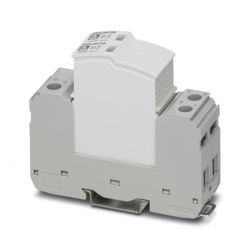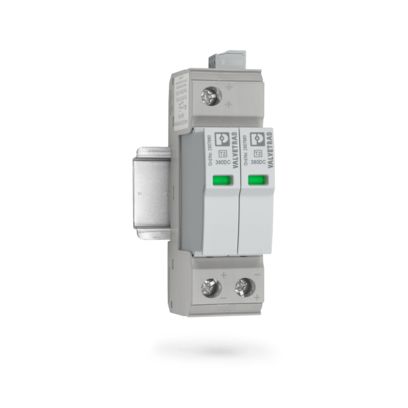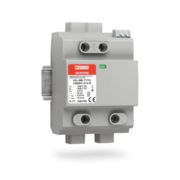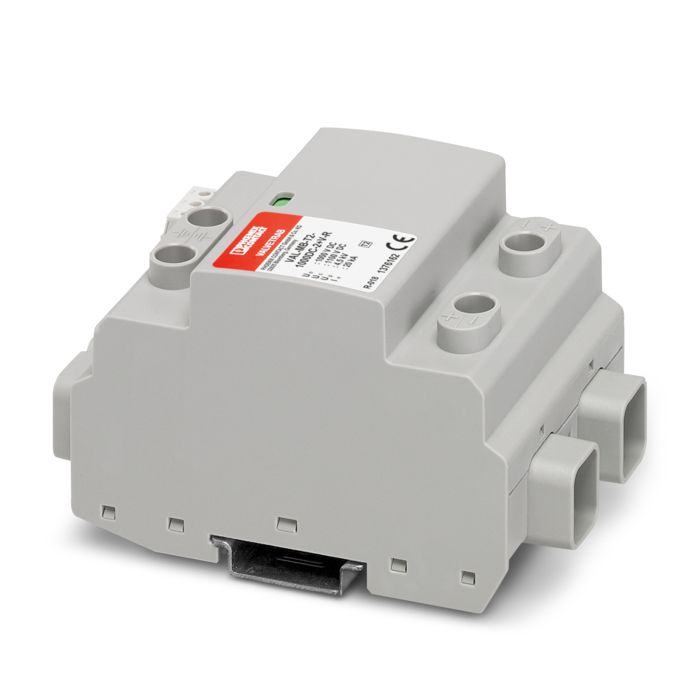
Pluggable surge protective device, in accordance with Type 2/Class II, for DC power sources with linear operating characteristics, with remote indication contact.


Due to their structure, direct current systems exhibit a different behavior during regular operation and in the event of an error than alternating current systems. Consequently, they require specific surge protective devices. Depending on the installation location and requirements, these SPDs are subdivided into type 1 and type 2 protective devices.

Pluggable surge protective device, in accordance with Type 2/Class II, for DC power sources with linear operating characteristics, with remote indication contact.

Lightning/surge protective device, according to type 1/2 / class I/II, for linear, unipolar DC supply systems up to 1000 V DC, for DIN rail mounting, with remote indication contact.

Pluggable surge protective device, in accordance with Type 2/Class II, for DC power sources with linear operating characteristics, with remote indication contact.

Pluggable surge protective device free of leakage current for 2-pos. isolated and grounded DC voltage systems with linear operating characteristic up to 120 V DC, for DIN rail mounting, 3-pos. base element with remote indication contact, three pluggable temperature-monitored protective elements, status message on each plug.

Pluggable surge protective device, in accordance with Type 2/Class II, for DC power sources with linear operating characteristics, with remote indication contact.

Pluggable surge protective device free of leakage current for 2-pos. isolated and grounded DC voltage systems with linear operating characteristic up to 380 V DC, for DIN rail mounting, 3-pos. base element with remote indication contact, three pluggable temperature-monitored protective elements, status message on each plug.

Universal varistor-based plug-in lightning/surge arrester for 1-phase power supply networks with common N and PE (2-conductor system: L1, PEN), with remote indication contact.

Universal varistor-based plug-in lightning/surge arrester for 1-phase power supply networks with common N and PE (2-conductor system: L1, PEN).

Pluggable surge protective device, in accordance with Type 2/Class II, for DC power sources with linear operating characteristics, with remote indication contact.

Replacement plug for surge protective devices from the VALVETRAB SEC product range for DC power sources.

DC grids offer numerous advantages over AC power grids and play an important role in the energy transition. The new VAL-MB-T1/T2-1000DC-2+V-R lightning current arrester reliably protects DC grids against damage caused by lightning currents and surge voltages.

Surge protective device for DC applications with nominal voltages up to 1,000 V DC
Surge protective devices for protecting DC applications must be adapted to what are in some cases much more stringent requirements. For use in DC systems with particularly high voltage, an SPD must be designed for up to 1,100 V continuous voltage. This is associated with much more stringent requirements for air clearances and creepage distances, which prevent sparkover between the connection terminal blocks and the conductors connected in them. For DC systems with smaller voltages, the requirements are not quite as stringent. However, here too the clear recommendation is to always select the surge protection for the appropriate voltage.
Alternating current or AC voltage offers two major advantages: It can be easily transformed and switched. During transport, however, reactive power is always transmitted as well, which leads to corresponding transmission losses.
Direct current or DC voltage offers the advantage that the desired voltages are used directly at the corresponding systems, machines, and devices via more efficient DC/DC or DC/AC converters. Complex DC intermediate circuits with AC/DC conversion in frequency converters are no longer necessary. In addition, no reactive power is transported in DC transmission systems. This significantly reduces energy losses during transport.